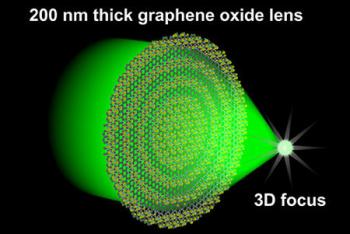Researchers at Swinburne University of Technology, collaborating with Monash University, have developed an ultrathin, flat, lightweight graphene oxide optical lens with extraordinary flexibility, that enables potential applications in on-chip nanophotonics and improves the conversion process of solar cells. It might also open up new possibilities in areas like non-invasive 3D biomedical imaging, aerospace photonics, micromachines and more.

Recent developments in nano-optics and on-chip photonic systems have increased the demand for ultrathin flat lenses with 3D subwavelength focusing capability (the ability to see details of an object smaller than 200 nanometres). A number of ultrathin flat lens concepts have been developed, but their real-life application is limited due to their complex design, narrow operational bandwidth and time consuming manufacturing processes. This lens, however, has a 3D subwavelength capability that is 30 times more efficient, able to tightly focus broadband light from the visible to the near infrared, and offers a simple and low-cost manufacturing method.
The researchers produced a film that is 300 times thinner than a sheet of paper by converting graphene oxide film to reduced graphene oxide through a photoreduction process. The researchers believe that the flexible graphene oxide lenses have the potential to revolutionize the next-generation integrated optical systems by making miniaturised and fully flexible photonics devices, as well as open up a new high-tech application for graphene oxide and demonstrate how nanotechnology can add significant value to natural graphite.

